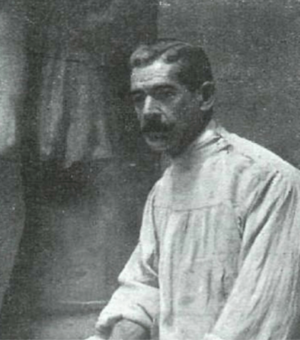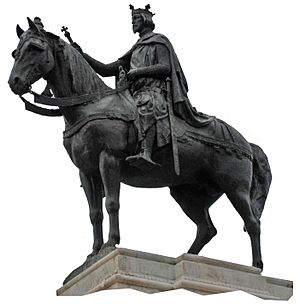Joaquín Bilbao facts for kids
Quick facts for kids
Joaquín Bilbao
|
|
|---|---|
 |
|
| Born |
Joaquín Bilbao Martínez
August 27, 1864 |
| Died | January 30, 1934 (aged 69) Sevilla, Spain
|
| Nationality | Spanish |
| Education | University of Seville, Sevilla Académie des Beaux-Arts, Paris |
| Known for | Drawing and Sculpture |
|
Notable work
|
|
Joaquín Bilbao Martínez (born August 27, 1864 – died January 30, 1934) was a famous Spanish sculptor. He created many amazing artworks. One of his most well-known pieces is the large equestrian statue of Ferdinand III of Castile. You can find this statue in the Plaza Nueva, Seville, right across from the City Hall.
Contents
Early Life and Education
Joaquín Bilbao was born in Sevilla, Spain, on August 27, 1864. His brother, Gonzalo Bilbao, was also a well-known painter.
Joaquín started his schooling at the Colegio San Alberto Magno. Later, he studied for his high school diploma at the Provincial Institute. During these years, he and his brother Gonzalo took drawing and watercolor classes. Their teacher was Professor Pedro Vega.
In 1881, after finishing high school, Joaquín decided to study law. He enrolled in the Faculty of Law at the old Literary University of Seville. He completed his law studies in 1887. By 1890, he was working at a law firm. However, at the age of 29, he decided to follow his true passion. He left his legal career to become a full-time sculptor.
A Sculptor's Journey
In 1900, Joaquín Bilbao moved to Paris, France. For four years, he attended the famous Académie des Beaux-Arts, a top art school. While in Paris, he also traveled to other countries like Belgium, the Netherlands, Germany, and England. These trips helped him learn from other artists. For example, in the Netherlands and Belgium, he studied the works of Constantin Meunier.
Even though he was abroad, Joaquín stayed in touch with the Academy of Fine Arts in Seville. He also participated in Spanish national art exhibitions. In 1904, he returned to Seville. That same year, the Academy of Fine Arts made him a member of the Provincial Commission of Historical and Artistic Monuments for Sculpture.
In 1909, Bilbao moved to Toledo, another city in Spain. There, he became a professor at the School of Arts and Crafts of Toledo. He also worked as a conservator at the Casa Museo del Greco, a museum dedicated to the famous painter El Greco. In 1902, he was honored with the title of Ordinary Commander of the Civil Order of Alfonso XII.
Joaquín Bilbao returned to his hometown of Seville in 1912. He stayed there for the rest of his life, only taking occasional trips. From 1914 to 1919, a young artist named Enrique Pérez Comendador studied with him. Enrique later created a bronze bust of his teacher.
Joaquín Bilbao passed away in Seville on January 30, 1934.
Famous Works of Art
Joaquín Bilbao created many important artworks. Here are some of his selected pieces:
Drawings and Paintings
- Two landscapes of Alcalá de Guadaíra (1890)
- Arab Sheikh (1899)
- Dream of Love (1897)
- The dream of the Virgin (1897)
- The vision of Fray Martín (1897)
- The vision of Saint Anthony (1897)
- Sketch of a statue for the rancher Félix de Urcola (1900)
- Regretful Eva (1920)
Sculptures
- Bust of Flora Bilbao (1896), found at the Museum of Fine Arts of Seville
- Commemorative tablet for the 3rd centenary of the birth of Cervantes (1899), located in the Church of San Pedro, Seville
- Bust of Teresa Parladé, Marchioness of Yanduri (1900)
- Statue of Antonio Cánovas del Castillo (1901), at the Palacio del Senado
- Copper medal with a portrait of Gonzalo Bilbao (1910)
- Mausoleum of Cardinal Marcelo Spínola y Maestre (1912), in Seville Cathedral
- Figures from the altarpiece of Christ of Maracaibo (1913), also in Seville Cathedral
- El Salvador and the apostles for the upper part of the Puerta de la Concepción (1917), Seville Cathedral
- Restoration of the Virgin of the Patronage of the Hermandad del Cachorro (1921), Seville
- Figure of the Arts for the Monument to Alfonso XII (1922), Madrid
- Statue of Ferdinand III of Castile (1924), Seville
- Temple of the Niño Jesús del Dulce Nombre (1925), at Santa María Magdalena, Seville
- Medallion with a portrait of Francisco Mateos Gago for his tombstone (1930)
See also
 In Spanish: Joaquín Bilbao para niños
In Spanish: Joaquín Bilbao para niños



